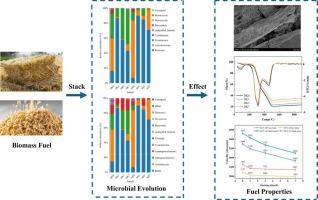Evolution of microbial communities in biomass stacks during the self-heating process and their influence on fuel properties
IF 6.2
1区 农林科学
Q1 AGRICULTURAL ENGINEERING
引用次数: 0
Abstract
Biomass industry development requires large-scale storage of biomass feedstock, but microbial growth in biomass stacks may result in self-heating, smouldering, and safety risks. The 16S rRNA/ITS high-throughput sequencing was employed to investigate the bacterial and fungal community evolution with rice husk and wheat straw. The dominant bacterial and fungal communities were identified based on the relative abundance and alpha diversity analysis. The results showed that the bacteria in the initial biomass samples were mainly Actinobacteriota, Proteobacteria, and Firmicutes. The fungi were mostly Ascomycota and Basidiomycota. Both samples' species richness went down with the increasing stacking time. Field emission scanning electron microscopy (FESEM), biomass fraction analysis, calorific value testing and thermogravimetric-differential scanning calorimetry (TG-DSC) were used to examine the impact of microbial life activities on the microstructure and chemical composition of biomass fuel. The findings indicated that microbial life activities had significant effect on microstructure damage of biomass materials. Hemicellulose was more vulnerable to microbial degradation than cellulose and lignin. Rice husk and wheat straw 's gross calorific value declined by 9.35 %, and 22.35 % in the 7 days stacking, respectively. Fuel analysis revealed that wheat straw was more susceptible to self-heating and spontaneous combustion than rice husk.

生物质堆自热过程中微生物群落的演化及其对燃料性能的影响
生物质产业的发展需要大规模储存生物质原料,但生物质堆中的微生物生长可能导致自热、闷烧和安全风险。采用16S rRNA/ITS高通量测序技术研究稻壳和麦秸细菌和真菌群落的进化。根据相对丰度和α多样性分析,确定了优势菌群和真菌群落。结果表明,初始生物量样品中的细菌主要为放线菌门、变形菌门和厚壁菌门。真菌以子囊菌门和担子菌门为主。两种样品的物种丰富度均随堆积时间的增加而降低。采用场发射扫描电镜(FESEM)、生物质组分分析、热值测试和热重差示扫描量热法(TG-DSC)研究了微生物生命活动对生物质燃料微观结构和化学成分的影响。结果表明,微生物活动对生物质材料的微观结构损伤有显著影响。半纤维素比纤维素和木质素更容易被微生物降解。稻壳和麦秸的总热值在7 d内分别下降了9.35 %和22.35 %。燃料分析表明,麦秸比稻壳更容易发生自热和自燃。
本文章由计算机程序翻译,如有差异,请以英文原文为准。
求助全文
约1分钟内获得全文
求助全文
来源期刊

Industrial Crops and Products
农林科学-农业工程
CiteScore
9.50
自引率
8.50%
发文量
1518
审稿时长
43 days
期刊介绍:
Industrial Crops and Products is an International Journal publishing academic and industrial research on industrial (defined as non-food/non-feed) crops and products. Papers concern both crop-oriented and bio-based materials from crops-oriented research, and should be of interest to an international audience, hypothesis driven, and where comparisons are made statistics performed.
 求助内容:
求助内容: 应助结果提醒方式:
应助结果提醒方式:


